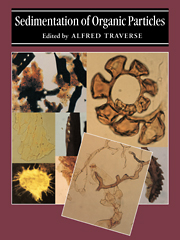Book contents
- Frontmatter
- Contents
- Editor's preface
- List of contributors
- I Introduction
- II Studies of palynosedimentation in modern environments
- 2 The sorting of spores and pollen by water: experimental and field evidence
- 3 Transport and deposition of pollen in an estuary: signature of the landscape
- 4 Pollen preservation in alkaline soils of the American Southwest
- 5 Wind and water transport and sedimentation of miospores along two rivers subject to major floods and entering the Mediterranean Sea at Calvi (Corsica, France)
- 6 Sedimentation of land-derived palynomorphs in the Trinity–Galveston Bay area, Texas
- 7 The genesis and sedimentation of phytoclasts with examples from coastal environments
- 8 Palynofacies of some recent marine sediments: the role of transportation
- 9 Maceral palynofacies of the Louisiana deltaic plain in terms of organic constituents and hydrocarbon potential
- 10 Organic sedimentation in a carbonate region
- 11 An approach to a standard terminology for palynodebris
- 12 Relationships of palynofacies to coal-depositional environments in the upper Paleocene of the Gulf Coast Basin, Texas, and the Powder River Basin, Montana and Wyoming
- III Reconstruction of late Cenozoic vegetation and sedimentary environments from palynological data
- IV Application of data on palynosedimentation to solution of geological problems
- V Appendix
- Index
9 - Maceral palynofacies of the Louisiana deltaic plain in terms of organic constituents and hydrocarbon potential
Published online by Cambridge University Press: 06 January 2010
- Frontmatter
- Contents
- Editor's preface
- List of contributors
- I Introduction
- II Studies of palynosedimentation in modern environments
- 2 The sorting of spores and pollen by water: experimental and field evidence
- 3 Transport and deposition of pollen in an estuary: signature of the landscape
- 4 Pollen preservation in alkaline soils of the American Southwest
- 5 Wind and water transport and sedimentation of miospores along two rivers subject to major floods and entering the Mediterranean Sea at Calvi (Corsica, France)
- 6 Sedimentation of land-derived palynomorphs in the Trinity–Galveston Bay area, Texas
- 7 The genesis and sedimentation of phytoclasts with examples from coastal environments
- 8 Palynofacies of some recent marine sediments: the role of transportation
- 9 Maceral palynofacies of the Louisiana deltaic plain in terms of organic constituents and hydrocarbon potential
- 10 Organic sedimentation in a carbonate region
- 11 An approach to a standard terminology for palynodebris
- 12 Relationships of palynofacies to coal-depositional environments in the upper Paleocene of the Gulf Coast Basin, Texas, and the Powder River Basin, Montana and Wyoming
- III Reconstruction of late Cenozoic vegetation and sedimentary environments from palynological data
- IV Application of data on palynosedimentation to solution of geological problems
- V Appendix
- Index
Summary
Introduction
Geologists have studied most aspects of sediments in order to elucidate characteristics significant in determining the environment of deposition. Traditionally the lithotype + biotype = rock approach has led to the concept of lithotopes and biotopes (environmental derivatives of lithotype and biotype), and the very successful concepts of lithostratigraphy, biostratigraphy and chronostratigraphy. It is clear that no single parameter can be used to distinguish all depositional environments, but if a number of parameters are measured, chances of error may be reduced. Unfortunately, which parameters are of most importance is unclear. Much of this uncertainty exists because sampling of the environments has been inadequate, and available data bases are poorly defined. Moreover, conclusions are rarely based upon the principles of experimental design and hypothesis testing.
The accessibility of samples strongly influences the choice of a sampling design, and, for the determination of depositional environment this is a particularly significant constraint. If outcrops are studied, a wealth of information relating to paleoenvironments becomes available; if conventional cores are studied the quantity of possible information is reduced, and even further so by sidewall cores. Unfortunately, the most abundant kind of sample available to the subsurface geologist is the collection of cuttings from the rotary bore. The information available from cuttings is indeed minimal, and even with good samples the derived information may be of reduced value due to caving and other problems connected with taking samples. Unfortunately for the subsurface geologist well cuttings with occasional sidewall cores are the rule rather than the exception.
- Type
- Chapter
- Information
- Sedimentation of Organic Particles , pp. 141 - 176Publisher: Cambridge University PressPrint publication year: 1994
- 6
- Cited by



